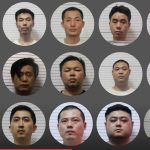Photograph by Nathaniel St. Clair
In the shadow of New York City, the biggest and one of the bluesiest cities in America, Nassau and Suffolk Counties have seen a growth of far-right /anti-government groups. These groups designated by the Southern Poverty Law Center as anti-government include a Nassau County chapter of the Proud Boys, Loud Majority (active in both Suffolk and Nassau Counties), Tactical Civics Mutual Assistance Group (Nassau County), and Moms for Liberty. From truck parades donning Trump flags while promoting conspiracies of immigrants voting illegally to so-called concerned mothers at school board meetings trying to ban any material that is, in their view, defined as White apologetic or a reference to LGBQT, have many believing this movement came out of nowhere.
But this right-wing culture war has not popped out of thin air. The ultra-conservatism and xenophobia of Nassau and Suffolk are baked into its development of the suburbs as far back as 100 years ago. Even though the term Great Replacement Theory was coined over a decade ago, the fear of replacing a White Protestant majority with who they view as an inferior group of immigrants set to shift demographics against the dominant majority has been a recurring theme in the region’s history.
Long Island was rapidly changing in the 1920s, like most urban sprawl in America. The region defined itself by White Protestant values, but the population was changing to a different religion, with its followers speaking a foreign language. Southern and Eastern European immigration was at its peak, and many of these immigrants were Catholic. Increasing Catholic demographics significantly impacted Long Islands’ Kings, Queens, Nassau, and Suffolk counties, which grew by 40% in 1920 to 800,000.
Along with the rise in Catholicism came a decline in the proportion of Protestants. In 1900, Protestants comprised 47.40% of the population of New York City and the surrounding metropolitan area. Within ten years, only 34.55% identified as Protestant. Coupled with the fear of increasing crime from Prohibition, the counties of Nassau and Suffolk had an insurgence of Klan influence, which was financially driven by its membership of middle-class residents. The local Klan manual, Klansmen: Guardian of Liberty, declared that “the Klan is not anti-Catholic, anti-Jew, anti-Negro or anti-foreign, it is Pro-Protestant and Pro-American.” Through their messaging of traditional American values, a White Protestant moral mandate, and a “law and order” stance, local membership grew to as much as an estimated one and seven Nassau and Suffolk County residents. From this membership, elected officials scrambled to embrace Klan values in return for their votes.
One of the largest villages in Nassau County, Freeport had the vast majority of local Republican officials get a cross-endorsement from the Klan-influenced party, The People’s Ticket. Various Klan members fueling claims of voter fraud from immigrant Catholics got some Republican party committee district leaders to assign dozens of Klan members as poll watchers during the general election. Following the successful win, local armed citizen militia Citizens League and Southside Law Enforcement League were established across the county for night patrols seeking rumors of rumrunning, gambling, or immoral acts, which focused their patrols on immigrants and communities of color. In one such area within Freeport, citizen militias lit a twenty-five-foot cross on fire and nailed a letter to an adjacent door that read, “Beware: the eye of the Klan is on you.”
As the mid-twenties progressed, New York elected Democratic Governor Al Smith, who would become the first Catholic to hold the office in the state. The official Klan newspaper Vigilance reported that Al Smith was conspiring to make America a colony of the Roman Church. The Kourier Magazine declared in July 1927 that the “Catholic church teaches disloyalty to America and electing Catholic Governor Alfred Smith will purposely promote the breakdown of America and its values.” Strengthening its messaging/conspiracy theories through local media, the Klan would publish various affiliated newspapers, spurring distrust and promoting themselves as true saviors of liberty. Mega Klan rallies, such as the Nassau County Mineola Fair Ground rally of July 3rd– 6th, 1926, attracted over 20,000 people. This rally’s theme was a battle cry to regain traditional American values. Using the large turnout and media messaging to energize their base, the Klan would build its political stronghold throughout Long Island into the 1930s.
However, despite the growth in influence, demographics were against the Klan. During World War II, most, if not all, Klan chapters ceased operation due to declining membership. The culture of racial segregation, combined with the growth of a new generation of immigrants from regions outside of Europe and African Americans joining the middle class, cemented the post-war suburban racial covenant clauses. One such town utilizing the clause is the Island’s most expansive development, Levittown. William J. Levitt, developer of Levittown Nassau County, validated his white-only housing clause by stating:
“As a Jew, I have no room in my mind or heart for racial prejudice. But I have come to know that if we sell one house to a Negro family, then 90 or 95 percent of our white customers will not buy into the community. This is their attitude, not ours. As a company, our position is simply this: We can solve a housing problem, or we can try to solve a racial problem, but we cannot combine the two.”
The racial covenants of Levittown would remain a fixture in all lease-to-buy homes until 1968. Fifty-seven years later, the consequences of the socially engineered town and the surrounding communities groomed a culture that accepted the racial divides as de facto practices of the housing market. According to the 2010 census data, Long Island (Nassau and Suffolk Counties) comprises one of the top twenty racially segregated communities in the United States. Results of the 2020 Census reflect a growth in the overall diversity of the population but have made modest gains in becoming more racially integrated.
The ethnic group that had some of the most significant gains was Hispanics. Since 2010, Hispanics have had a steady growth of 18%, which reflects both counties’ population comprising 14.7% of the population to an estimated 21% in 2020. Relics of these racial restrictions and the growth of a robust Hispanic population created the perfect storm for embracing the Replacement Theory for another generation. In a similar style to a century ago, far-right extremists are attempting to wage a culture war against changing demographics and social progress. Replacing the Klan periodicals, circulated a century ago with YouTube channels and podcasts hosted by Loud Majority co-founder Kevin Smith, have gained over 160,031 views on their Rumble platform. Episodes spewing their definition of liberty/ Americanism through dog whistle bigotry in opposition to the so-called woke left are energizing a growing extremist base.
In contrast to popular belief, many members of these groups are not on the fridges of poverty or chronically unemployed but represent a segment of the middle class like the Klan of the 1920s. According to a study by the Southern Poverty Law Center, the anti-government and xenophobia groups have professionals in their ranks that include teachers, firemen, law enforcement, nurses, and former military, to name a few. Law Center researcher Rachel Carroll Rivas explained, “These groups purposefully recruit among people who hold leadership positions, and it lends credibility to their extremist ideas.” Unlike the 20’s Klan who joined the trash heap of history, these far-right groups are attaching themselves to the federal Republican Party establishment. The guest speaker at one of the many Loud Majority Rallies was former Congressman and Trump’s new pick for the EPA, Lee Zeldin.
However, the political validation for their groups does not end there. In the aftermath of the January 6th riots at the Capital, nine Long Island residents were indicted on charges ranging from criminal trespassing to assault on law enforcement or rioting. Reframing January 6th as a “Day of Love,” Trump made good on his promise of blanket pardons or reduced jail time for rioters. Upon leaving prison after his pardon for seditious conspiracy stemming from the January 6th, Proud Boy’s leader Enrique Tarrio stated, “I’m happy that the president’s focusing not on retribution and focusing on success, but I will tell you that I’m not going to play by those rules. They need to pay for what they did.” Compounding the political validation of groups the Southern Poverty Law Center designated as anti-government or anti-immigrant, President Trump has openly pledged to fire FBI agents who have investigated any groups involved in January 6th. This shake-up at the FBI and modeling that these groups will not be held accountable for violent acts can potentially empower a new violent stage of an already contentious “culture war” on Long Island and nationally.









